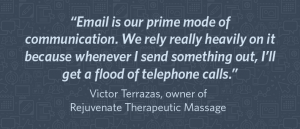It’s a beautiful thing when you find a marketing strategy that people want more of. Every day, we’re shown thousands of advertising messages, most of which we’re blind to. But believe it or not, 43% of people want to see more video content from marketers – a key statistic that should be your call to action for adding video into your strategy.
Video has changed our browsing experience for good. YouTube has over a billion users, almost one-third of total internet users, and is one of the most frequently used search engines. More video content is uploaded in 30 days than the major U.S. television networks have created in 30 years. We create video narratives of our lives through vlogs or dedicated YouTube channels.
Why Video Matters
Sure, people may want to see more video content, but what value does it really offer? Research and case studies show that video can aid in fundamental brand activities like building trust, establishing credibility, and generating engagement.
- How Video Can Help You Build Relationships & Trust With Your Customers
- Enhancing Culture & Brand Engagement Through Video
- How to Use Online Video to Establish Credibility
- The State of Video Marketing 2017
Have you ever felt frustrated by a key message not sinking in with your audience? Video may be the tipping point. Viewers retain 95% of a message when they watch it in a video compared to 10% when reading it in text. Anyone who sells a product with some assembly or explanation required can appreciate the importance of information retention in their customer base.
The benefits are clear – and it doesn’t hurt that 51% of marketing professionals worldwide name video as the type of content with the best ROI.
How Can I Add Video To My Marketing Strategy (Without Making Ads)?
Enriching your user experience with videos that aren’t just ads is all about reaching people in their micro-moments, or the moments when we turn to our devices for answers when we want to know something, do something, buy something, or go somewhere.
By understanding a user’s intention when engaging with your marketing (i.e. those learn, do, go, or buy activities), you can create videos that add value to their experiences and lead them down the path to conversion. In fact, according to Visually, adding video to a landing page can increase conversions by 80% or more, and home page videos can boost conversions by 20%.
The key to incorporating video into your marketing strategy is to get intimately familiar with:
- What is visually interesting and valuable to your audience
- What people are searching for
- What the intention is behind the searches
Here are a few ways to apply those insights in a practical way to improve engagement, conversion rates, audience perceptions, trust, and social reach.
Q&A Sessions: No matter what industry you’re in, there are bound to be questions. Video Q&A sessions with members of your team or industry thought leaders can be a great way to reinforce your position as a knowledgeable and trustworthy resource for information and guidance when your customers need it most. Plus, it can drive additional search traffic to your content properties by reaching searchers when they have a query in mind. For example, Warby Parker has a help-related YouTube channel that gives video answers to frequently asked customer service questions while also capturing search traffic from prospective customers looking for answers.
Product Demonstrations/How Tos: Your customers are looking for ways to use and understand your products or services, so why not meet them at the moment when they start their research by creating a video that can show what you do or what you offer in action? Explainer and product demonstration videos can be a powerful marketing tool when you have a product that pays to show in use or in greater detail, especially if you can find a unique way to present the information. Just take a look at Blendtec’s “Will It Blend?” Series which showed the power of the product by introducing unexpected – and funny! – use cases.
Testimonials: Adding video testimonials to your site or social channels can also be a powerful strategy by tapping into buyer psychology. Demonstrations of concensus or endorsement by others with like qualities or characteristics through social proof can instill a greater sense of trust and be a powerful persuasion tool. As a case study, ChowNow uses professionally-produced video testimonials to sell their benefits while showing real customers in real situations. Don’t just tell, show.
Social Media Storytelling: Social platforms have evolved with user’s growing demand for more video content. Facebook, Instagram, Snapchat, and Twitter have video features to enrich the experience of participating in an online community. Brands can easily post videos to their social accounts or even livestream as a way of adding context to their brand stories. Buzzfeed does this effectively by launching its own original shows/programming, distributing across social, and livestreaming to its already engaged audience. Video content is frequently shared throughout social channels to increase reach – and it works. Social video generates 1200% more shares than text and images combined.
Education & Conversation: Sometimes you have a customer base that wants to continue learning. Why not make video content to educate and start a dialogue? Take wine, for instance. Wine Library TV understood that shopping for wine is a highly personal and customizable experience that can be improved by giving customers a bit more information about what they’re shopping for and how to make better choices. Branded video content can also create and redefine conversations that are important to your audience in ways that can start entire movements.
Cross-Promotion: Besides enriching your website and social media efforts, video can be a helpful tool for content cross-promotion. Authors often use video teasers or trailers as a way to sell audiences on their latest book. Conferences share clips or recorded sessions to sell the value of the event prior to tickets going on sale. Publishers turn blog posts into video presentations. Musicians make music videos or lyric animations to further the reach of their latest releases. Try incorporating video trailers, teasers, and previews as a way to give your content additional mileage while generating interest through a new interpretation of your work.
A Few Best Practices To Keep In Mind
- Have a goal in mind before you film and align the video content you create with stages in your customer journey.
- Making a testimonial? Be genuine and focus on the benefits.
- Add transcripts to your YouTube video description, landing pages, or blog posts where videos are embedded so that your video content is more accessible for search.
- Include captioning as part of your recorded video to ensure a better user experience, as 85% of Facebook videos are watched without sound.
- Suit the video to the distribution platform, especially on social.
- Boost your video’s adoption through supporting it with paid advertising. Don’t rely simply on organic views to get your content seen.
- Keep it short and sweet. Videos under 90 seconds see an average retention rate of 53%.
- Practice product video mindfulness. As you consume video content, ask questions about whether or not it’s clear, tells a story, or adds value to the brand. Don’t copy, but learn from what other brands have done successfully through video.
Tools To Get Started
Starting with video can be as simple as using your built-in laptop, tablet, or smartphone camera. With technology at our fingertips, it’s never been easier to make and share a video.
But there are some tools that you can use to make, edit, share, and measure videos in your online marketing efforts:
And of course there are live streaming or social in-app solutions too! Key principles to keep in mind no matter which tools you choose to use: make sure the video looks good, sounds good, is accessible, and offers solid content. As Brightcove reports, 62% of consumers are more likely to have a negative perception of a brand that published a poor quality video.
But beyond these DIY solutions, you can also look to partner with a trusted video production company who understands your marketing goals and can collaborate with you. There’s nothing wrong with seeking out help from the pros.
Measuring Video Success
View stats may seem great, but are they really telling you what’s happening with your video content?
Measuring the effectiveness of your videos is a must-have for any marketer and there are lot of ways you can approach the subject of KPIs. For some brands, awareness and hit stats are all they want to see, but if you really want to see the impact of the content you’re producing, you have to look at engagement stats. What’s the average view look like? Where do people stop watching? How do they interact with the links or transcripts? What actions do they take on the page after watching the video?
Google BrandLab has a great resource on how to determine the right KPIs for your video marketing efforts by aligning measurement with marketing goals.
Ultimately, it’s all about being mindful and attentive to how video adds value to your overall marketing strategy – and there’s a lot of value to be enjoyed by brands who can incorporate video effectively.
* Adapted lead image: Public Domain, pixabay.com via getstencil.com
The post Practical Tips For Integrating Video Into Your Marketing appeared first on Search Engine People Blog.
(64)










